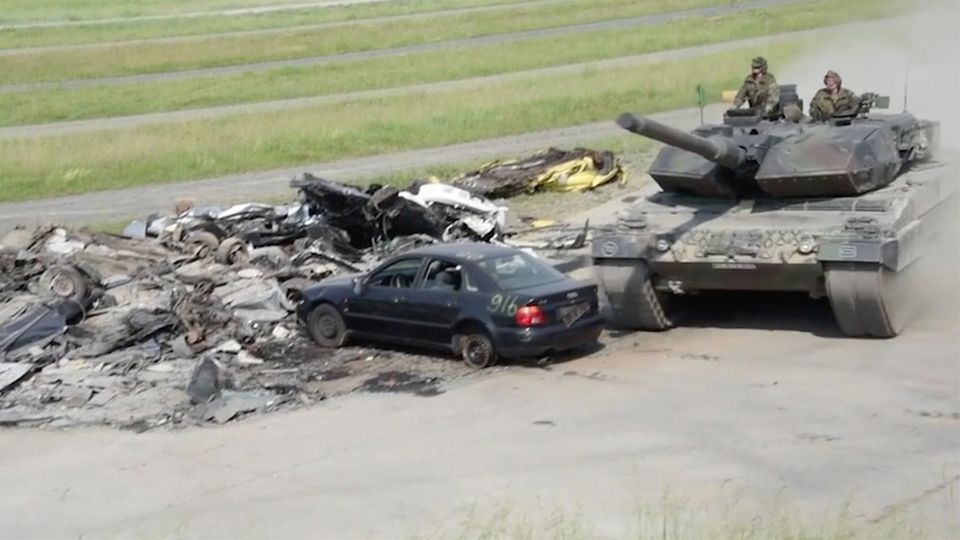Second World War
Sturmgeschütz III – Hitler’s deadliest tank killer
Stug III in the battles for Kharkov.
© Federal Archives / Commons
The assault gun was actually intended to combat bunkers and machine gun nests. But it became a feared anti-tank weapon. The dictator Hitler and his greatest strategist Erich von Manstein played a key role in the development.
The most successful German tank killer is not one of the popular pop stars of tank construction. The Sturmgeschütz III is small, inconspicuous and therefore particularly deadly. In the German system the Stug III was not even considered Main battle tank led. It belonged to the assault artillery. The Germans grouped their “real” tanks into their own formations, which were supposed to achieve quick attacks and deep breakthroughs, independent of the slow infantry.
The infantry units were given mobile, lightly armored cannons that were intended to help them use their firepower to directly combat enemy positions and bunkers. They had the classic role of a support tank, as had already been used in the First World War. David Willey, curator of the British Tank Museum, describes it like this: “Mobile artillery, that was the idea. A cannon that you can take with you when the infantry advances:”
7 pictures
Short “stub” cannon
In Germany, General Erich von Manstein took up this idea in the 1930s. The assault gun was supposed to fire directly at shelters and machine-gun nests. This was a completely different role than that intended for the real tanks. The Panzer III platform was used for the gun – at the beginning of the war it was the standard German main battle tank. The program led to friction within the German Wehrmacht. Tank generals like Heinz Guderian fear that the parallel program would deprive them of important resources. But ultimately the supporters around Manstein, who is considered the best German strategist of the war, were able to prevail.
Unlike the Panzer III, the assault gun does not have a rotating turret – the cannon protrudes forward. It could be swiveled a little, but for larger movements the entire chassis had to be moved. The assault gun was no higher than a standing soldier.
For the original task, the comparatively small chassis was already equipped with a 75 mm caliber cannon; the Panzer III only had a 50 mm caliber cannon. But in order to fire explosive shells at trenches and bunkers, an extremely short cannon was chosen. The 7.5 cm StuK 37 L/24 was nicknamed “Stubble”. Its disadvantage: It could not fire effective armor-piercing shells; the muzzle velocity of the “stub” was not sufficient.
Effective main weapon for the assault gun
This only changed in 1942. A long cannon of the same caliber was installed in the F and later G variants. First the 7.5 cm StuK 40 L/43, then from autumn 1942 the 40 L/48. At the same time, the armor was strengthened. The new main weapon was the standard cannon of the Germans in World War II and remained an effective weapon capable of eliminating any enemy until the end of the war. It was only ineffective against the Allies’ extremely heavy tanks – such as the US Army’s Pershing and the Red Army’s Stalin II tank.

Adolf Hitler is often seen as a driving force in the development of ever heavier tanks, which became increasingly complex and vulnerable. In fact, the dictator played a major role in the development of the rather inconspicuous assault gun. He himself is said to have requested that the gun be equipped with the long cannon and stronger front armor.
The Stug III’s crouched silhouette and main weapon firepower transformed it into an anti-tank weapon. Added to this was the high level of training in the first units.
The gun quickly became a feared tank killer. The Soviets developed special tactics to deal with the new threat. The Stug III only had effective armor at the front and was relatively slow. When the Soviets encountered a unit, they did not attack head-on, but instead attempted to bypass the Germans and attack from the flank.
The Stug II became the most frequently built full-track vehicle by the Germans. In production, the gun always enjoyed higher priority than the famous Panther and Tiger models. From the outside you could see the pieced together and improvised development. However, the assault gun was significantly cheaper to produce and easier to produce than later main battle tanks. A Tiger cost 260,000 Reichsmarks, the Stug III only 82,000. An anti-tank gun with the necessary towing vehicle costs over 40,000 Reichsmarks.
Inferior to the T-34
As the war progressed, the Germans tried to improve the concept and transfer it to larger tanks. But ultimately, with the complicated developments, they lost the advantage of simple production. A Jagdpanther can be convincing as a unique piece and technical masterpiece, but overall the development of such a complex vehicle without a turret was a wrong decision. Towards the end of the war they wanted to build a tank destroyer, the Hetzer, that was even smaller than the Sturmgeschütz III. But actually better solutions, such as the sloping armor, led to an excruciatingly tight space in the mini-tank.
In total, around 10,000 Sturmgeschütz IIIs were built. Although the gun was an effective concept, the Stug III could not stop the Allied tanks. The USA produced 50,000 Sherman M4 tanks and the USSR 80,000 T-34s. The Sturmgeschütz III was inferior to the T-34 in every respect – armor, speed and later also firepower – a German crew could only hope to fire at the attacking Soviet tanks from a hidden position before they discovered the gun.
Also read:
T-34 – this tank was Stalin’s miracle weapon
Panzerkampfwagen VI – Tiger I – all opponents feared this tank
Jagdpanzer 38t “Hetzer” – the mini tank with the big cannon



